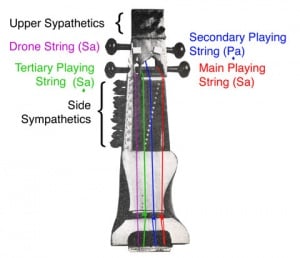Sarangi
The sarangi is a bowed string instrument of India, Nepal and Pakistan. It is the most important bowed string instrument of India's Hindustani classical music tradition. Of all Indian instruments, it is said to get closest to the sound of the human voice – able to imitate vocal ornaments such as gamakas (shakes) and meend (sliding movements).
Background
Sarangi music is vocal music. It is quite impossible to find a sarangi player who does not know the words of many classical songs. The words are usually mentally present during performance, and performance almost always adheres to the conventions of vocal performance including the organisational structure, the types of elaboration, the tempo, the relationship between sound and silence, and the presentation of khyal and thumri compositions. The vocal quality of sarangi is in a quite separate category from, for instance, the so-called gayaki-ang of sitar which attempts to imitate the nuances of khyal while overall conforming to the structures and usually keeping to the gat compositions of instrumental music.
In the words of Sir Yehudi Menuhin on Ram Narayan and his Sarangi: "The Sarangi remains not only the authentic and original Indian bowed stringed instrument but the one which most poignantly, and in the hands of Ram Narayan, most revealingly expresses the very soul of Indian feeling and thought. I cannot separate the Sarangi from Ram Narayan, so thoroughly fused are they, not only in my memory but in the fact of this sublime dedication of a great musician to an instrument which is no longer archaic because of the matchless way he has made it speak."
Sarangi in Sikhi
Guru Hargobind Sahib ji not only invented the Taus, but also incorporated the Sarangi into Sikh music. It was predominantly used in dhadi vara, however it is also used in Gurmat Sangeet. The two of these genres differ vastly, therefore they each have adapted Sarangis for their use, e.g dhadi vara uses a folk Sarangi, whereas Gurmat Sangeet uses a classical Sarangi.
Structure
Carved from a single block of wood, the sarangi has a box-like shape, usually around two feet long and around half a foot wide. The lower resonance chamber is hollowed out and covered with parchment and a decorated strip of leather at the waist which supports the elephant-shaped bridge. The bridge in turn supports the huge pressure of approximately 40 strings.
Three of the strings – the comparatively thick, tight and short ones – are bowed with a heavy horsehair bow and "stopped" not with the finger-tips but with the nails, cuticles and surrounding flesh (talcum powder is applied to the fingers as a lubricant). The remaining strings are resonance strings or tarabs (see: sympathetic strings), numbering up to around 35, divided into 4 different "choirs". On the lowest level are a diatonic row of 9 tarabs and a chromatic row of 15 tarabs, each encompassing a full octave plus 1–3 extra notes above or below. Between these lower tarabs and the main playing strings lie two more sets of longer tarabs, which pass over a small flat ivory bridge at the top of the instrument. These are tuned to the important tones (svaras) of the raga. A properly tuned sarangi will hum and buzz like a bee-hive, with tones played on any of the main strings eliciting echo-like resonances.
Sarangi in the modern world
Famously difficult to play and tune, the sarangi has traditionally been used primarily for accompanying singers (shadowing the vocalist's improvisations), but in recent times it has become recognised as a solo instrument used for full raga development – thanks to the single handed efforts of Pandit Ram Narayan. Other current celebrated performers include Sarangi Legend Ustad Sabri Khan, Ustad Sultan Khan ,Ustad Kamal Sabri, Aruna Narayan Kalle; eminent maestros of the past have included Ustad Bundu Khan, Ustad Md. Sagiruddin Khan and Pandit Gopal Mishra.
The repertoire of sarangi players is traditionally very closely related to vocal music. Nevertheless, a concert with a solo sarangi as the main item will probably include a full-scale raga presentation with an extensive alapa (the unmeasured improvisatory development of the raga) in increasing intensity (alapa-jhor-jhala) and several compositions in increasing tempi. As such, it is on a par with other instrumental styles such as for sitar, sarod, bansuri. This full-fledged raga development has its roots in the Dhrupad style of raga presentation.
The sarangi is also a traditional stringed musical instrument of Nepal, commonly played by the oppressed Gaine ethnic group.
Sarangi players
In India
|
|
|
In Pakistan
|
|
|
|
In Nepal
|
|
|
Modern Performers that have used Sarangi in compositions
|
|
|
| Kirtan: | Raga · Taal · Ragmala · Classical Music · Sangeet · Dhuni · Divan · Asa di Var · Jatha · Simran · Shabad · Tuk · Rababi · Dhadhi |
| Ragas: | Asa · Bairari · Basant · Bhairon · Bihagara · Bilaval · Devagandhari · Dhanasari · Gauri · Gond · Gujari · Jaijavanti · Jaitsri · Kalian · Kanara · Kedara · Maajh · Malaar · Mali Gaura · Maru · Nat Narain · Prabhati · Ramkali · Sarang · Sri · Sorath · Suhi · Tilang · Todi · Tukhari · Vadahans |
| Ragis: | Harjinder Singh · Maninder Singh · Amolak Singh · Darshan Singh · Balwinder Singh · Harbans Singh · Anoop Singh · Niranjan Singh · Amrik Singh · Avtar Singh · Snatam Kaur ·Kamaljit Kaur · Dileep Kaur · Joginder Singh · SS Maskeen |
| Saaj: | Harmonium · Tabla · · Tanpura · Taus · Rabab · Sarangi · Dilruba · · Saranda · Sarode · Sitar · Santoor · Pakhawaj · Dhadh · Dholak · Dool |

